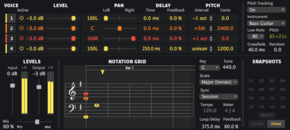

- Eventide h910 gearslut trial#
- Eventide h910 gearslut professional#
- Eventide h910 gearslut series#
- Eventide h910 gearslut mac#
David went on to create Rolls Corporation and John Johnson was hired by digitech in later years as a consultant. The lot was sold to Harman in 1990, because the 2 men were afraid the guitareffects-game was comming to a halt. Eventually, the DOD brand was subsumed under the Digitech label. David was the original engineer, but Johnson seems (or claims) to be the man of the ideas.ĭigiTech was created as a subcompagny in 1984 with the idea that DOD concentrated on effects pedals and Digitech focused on rack gear. Documents:ĭOD originally stood for David Oreste Di Francesco, who founded the company in 1973 with business partner and musician John Johnson. AMS Neve is still run by Mark Crabtree, who was the main productdesigner for AMS.īoth Mark Crabtree and Stuart Nevison were both awarded Fellow of the APRS. And after the Logic 1, the first dynamically configurable, fully automated digital mixing console.ĪMS was bought by Siemens in 1990 and merged it with NEVE electronics in 1992 (Rubert Neve was long gone by then). Last version of the DMX 15-80 with all options included AftermathĪMS went on to develop the worlds first commercially available harddisk recorder and editor, the Audiofile. (Collins' drum sound was created by a combination of a room microphone compressed by the "Listen Mic" compressor of an early SSL Console, in combination with cutting off the reverb sound with a noise gate.) S-DMX (1985?)

In addition to a range of reverb types, the RMX-16 had a program ("Non Lin 2") which digitally emulated the drum sound of a compressed and gated room microphone, copying the effect used on the Phil Collins recording In the Air Tonight. It had the exact same algorithms as the DMX15R, but with it's own converters. In 1981, AMS released the RMX-16 digital reverberator. Because AD/DA converters were such an expensive component at the time, it was decided to use the converters in the delays that already where in many studio's.

DMX15R Digital Reverb (1981)ĪMS's first reverb was an expansion of the DMX 15-80. The DMX later included pitch changing and up to 32 seconds of delay. THe DMX 15-80 is a stereo version of the machine and later the DMX included "loop triggering" launching the use of digital sampling. One of the early users of the AMS DMX 15-80 was Manchester record producer Martin Hannett. In 1978, AMS introduced the world's first microprocessor controlled, 15-bit digital delay line, the AMS DMX 15-80. This was used by ELO, 10cc and Paul McCartney, who used it on the Wings' London Town album in 1978. Their first product was the DM-20 Tape Phase Simulator.
Eventide h910 gearslut professional#
They were originally Aerospace engineers before getting into professional studio equipment for the manipulation and control of sound. Early years.ĪMS was founded by Mark Crabtree and Stuart Nevison in 1976. The company later merged with Neve Electronics to form AMS Neve.
Eventide h910 gearslut trial#
More information and a trial can be downloaded via Eventide’s webpage for the new H910 plugin.Were a manufacturer of professional studio equipment. This initial offer is very good considering the UAD version will set you back 189 GBP.

There is an introductory offer of 99 USD but it will eventually retail at 249 USD.
Eventide h910 gearslut mac#
The plugin is designed for Windows and Mac systems in VST, AU and AAX Native formats. This conveniently places two of the H910’s together, either with independent, linked or inverse processing for building stereo effects quickly. Many producers often used two Harmonizer’s for stereo processing, so with the new plugin you now also receive a ‘H910 Dual Harmonizer’ version. Having managed to achieve a like for like emulation of the hardware, and included all the usual plugin benefits with UAD, there is one other feature that they’ve added with this Native release. What’s more, they’ve added a dual channel mode new with this release. Far be it for me to say, but speculation suggests that this Eventide only version is extremely similar in sound, due to Eventide’s strong part in the development. Being a UAD plugin you’d be right to assume the high quality and striking emulation of the real thing. It was even used creatively in post production and is possibly responsible for what we all now consider a robot voice to sound like.Įventide already developed a plugin version of the H910 with UAD for the UAD platform. Most importantly though, probably due to it’s low resolution processing, it had a unique sound which we’ve learnt to love. In fact, the scope for different results from this unit is still more radical than some of the plugins we have today.
Eventide h910 gearslut series#
The H910 sports a series of pitch shifting, modulation and delay effects with interesting feedback methods. What does the H910 do? Well, Tony Visconti says the H910 “f*cks with the fabric of time”.


 0 kommentar(er)
0 kommentar(er)
